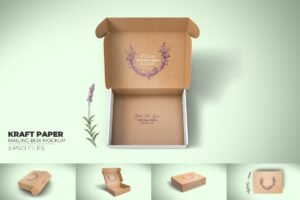What Are Rigid Boxes?
Rigid boxes are a type of packaging that exudes elegance and sophistication. They are known for their sturdy construction and high-end appearance, making them a preferred choice for luxury products. Unlike ordinary packaging, rigid boxes have a distinct structure that offers superior protection and presentation.

Understanding Rigid Boxes
A. Definition and characteristics
Rigid boxes are typically made with thick and rigid materials, providing a solid and durable framework. They have a defined shape and hold their form well, giving a sense of quality and permanence. The precise edges and smooth surfaces contribute to their refined look.
B. Materials commonly used (e.g., cardboard, paperboard, specialty coatings)
Cardboard is a popular choice for rigid boxes due to its strength and ability to be molded into various shapes. Paperboard offers a smooth finish and can be coated with specialty materials to enhance its appearance. Specialty coatings like varnish or laminate add a lustrous or textured effect, elevating the overall luxury feel.
Comparing Rigid Boxes vs Folding Cartons vs Corrugated Boxes
Rigid boxes differ significantly from folding cartons and corrugated boxes. Folding cartons are more flexible and are suitable for products that don’t require the same level of protection or presentation. Corrugated boxes, on the other hand, are known for their strength but may lack the aesthetic appeal of rigid boxes. Rigid boxes stand out for their premium look and ability to showcase products in an upscale manner.
| Features | Rigid Boxes | Folded Cartons | Corrugated Boxes |
| Setup | None if not foldable | Needed | Needed |
| Sturdiness | High | Low | High |
| Product safety | High | High with the aid of inserts | High |
| Cost | Generally high | Depends on printing and finish | Depends on printing and finish |
| Appeal | Generally high | Depends on printing and finish | Depends on printing and finish |
| Reusable | Yes | Usually not | Yes |
Design Elements of Rigid Boxes
A. Shape and size options
Rigid boxes come in a wide array of shapes and sizes to accommodate different products. From square and rectangular to more unconventional forms, the possibilities are endless. The choice of shape can enhance the visual appeal and make the product stand out on the shelf.
B. Decorative techniques
Embossing creates raised patterns or designs on the surface of the box, adding texture and depth. Debossing, on the contrary, creates indented impressions, giving a subtle and elegant effect. Foil stamping adds a metallic shine and can be used to highlight logos or key elements, enhancing the brand image.
C. Color choices and their impact
The color of a rigid box plays a crucial role in its overall impact. Rich and bold colors convey a sense of luxury and exclusivity, while soft and pastel tones offer a more delicate and sophisticated look. The choice of color should complement the brand and the product inside.
Manufacturing Process of Rigid Boxes
A. Steps involved
The manufacturing process begins with cutting the materials to the desired size and shape. Folding is then done to create the box structure, followed by gluing to ensure a secure and seamless finish. Each step requires precision and attention to detail to achieve the perfect box.
B. Quality control measures
Quality control is essential to ensure that every rigid box meets the highest standards. This includes checking for proper dimensions, adhesion, and the absence of defects. Only boxes that pass these rigorous inspections are ready for use.

Applications of Rigid Boxes in Different Industries
A. Cosmetics and beauty
In the cosmetics industry, rigid boxes are used to package high-end perfumes, makeup sets, and skincare products. The luxurious packaging enhances the perceived value of the products and attracts discerning customers.
B. Jewelry and watches
For precious jewelry and watches, rigid boxes provide the necessary protection while presenting the items in an elegant and prestigious manner. The box becomes an extension of the brand’s image and adds to the overall buying experience.
C. Food and beverages
In the high-end food and beverage sector, rigid boxes are used for premium chocolates, fine wines, and gourmet gift sets. The packaging not only protects the contents but also enhances the presentation, making it more appealing to consumers.
Customization Options for Rigid Boxes
A. Personalized printing and labeling
Personalized printing allows brands to showcase their unique logo, product information, and marketing messages. Labels can be designed to match the brand’s style and communicate key details to the customers.
B. Interior design and inserts
The interior of the rigid box can be customized with special inserts to hold the product securely and add an extra touch of luxury. Foam inserts, fabric linings, or custom compartments enhance the presentation and protection.
Sustainability in Rigid Box Packaging
A. Eco-friendly materials and practices
In an era of increasing environmental consciousness, rigid box manufacturers are exploring eco-friendly materials such as recycled cardboard and biodegradable coatings. Sustainable practices in production, such as reducing waste and energy consumption, are also becoming more prevalent.
B. Consumer perception of sustainable luxury packaging
Consumers are increasingly demanding sustainable options even in the luxury segment. Brands that adopt eco-friendly packaging not only contribute to the environment but also gain favor with consumers who value sustainability.
Trends in Rigid Box Luxury Packaging
Latest design and material trends
Current trends include minimalist designs with clean lines and simple yet impactful branding. Materials with unique textures and finishes are also in demand, as well as interactive packaging elements that engage the customer.

XI. Conclusion
Rigid boxes offer a comprehensive solution for luxury packaging. From their definition and characteristics to the manufacturing process and customization options, they provide a platform for brands to showcase their products in the most elegant and appealing way. With the continuous evolution of design and sustainability, rigid boxes are set to remain a staple in the luxury packaging industry.






